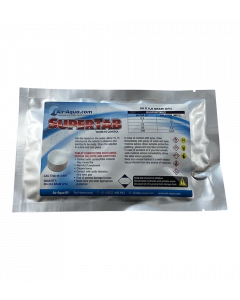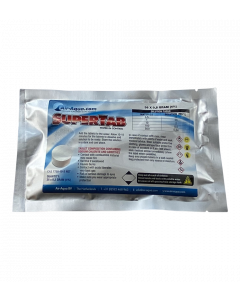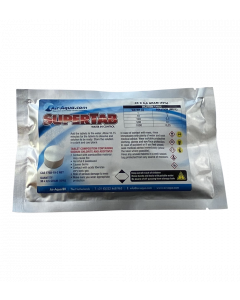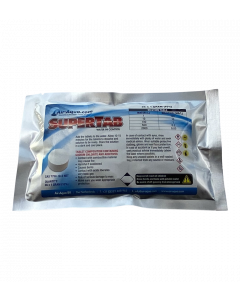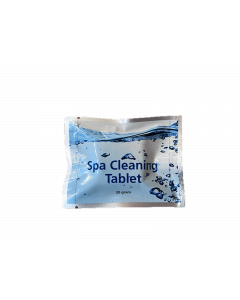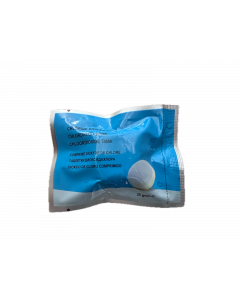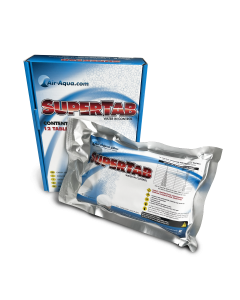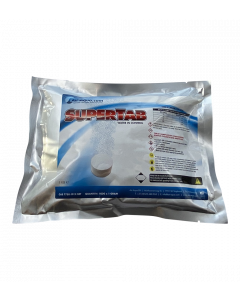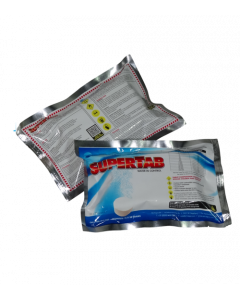Chlorine dioxide - ClO2
Reduces very effectively viruses, fungi and bacteria.
The SuperTab is a multi-component tablet, which when added to water, yields a very pure chlorine dioxide (O=Cl=O) solution. The SuperTab makes it possible to produce chlorine dioxide locally in a very simple manner: just add one tablet to the water.
As the SuperTab is supplied in a sealed foil consisting of four layers, chlorine dioxide has become easy and safe:
- to transport/ship
- to store, even for longer periods to use
Once the solution has been made, chlorine dioxide has a limited stability (approx. 6-12 weeks). The SuperTab offers the unique opportunity of always having ‘fresh’ chlorine dioxide on hand. Although chlorine forms part of the name chlorine dioxide, the product should not be compared to chlorine. A single atom makes a world of difference in a molecular structure. Such a difference can be compared to, for example, hydrogen. This is a very explosive gas. However, once it forms a bond with oxygen, it becomes dihydrogen monoxide, better known as water. Chlorine dioxide is very effective at killing pathogens, such as fungi, bacteria and viruses. Chlorine dioxide is a very selective oxidant, due to its low oxidative power. Other oxidants, such as chlorine and ozone, react with most organic compounds. In contrast, chlorine dioxide only reacts with weaker organic compounds and is therefore not used up quickly. This means that much lower doses of chlorine dioxide are required to create a stable residue than is the case for chlorine or ozone.
Due to this selectivity, chlorine dioxide can be used effectively to combat bacteria, viruses and fungi, if high concentrations of inorganic substances are present. Chlorine dioxide is very effective at low doses (0.1 ppm) and across a wide pH range. Chlorine dioxide enters via the bacterial cell wall and reacts with the amino acids in the cytoplasm of the cell, thereby killing the organism. The by-product of the reaction is similar to table salt (sodium chlorite). Therefore, the reaction product of chlorine dioxide does not pose any health hazards. This means that chlorine dioxide is an environmentally neutral technique, because it protects human health against pathogens such as bacteria, viruses and fungi on the one hand and on the other hand it does not form the by-products that a lot of other oxidants do form.
Controlled extermination of bacteria, viruses and fungi
Chlorine dioxide has a large number of benefits compared to chlorine and many other disinfectant techniques. These benefits are the result of the unique combination of a low oxidative power and a high oxidative capacity. Despite the lower oxidative power, chlorine dioxide has a better oxidative effect than chlorine on bacteria, spores and viruses, some of which cannot be eradicated using chlorine.
The sporicidal and virucidal effect of chlorine dioxide is better than that of chlorine at the same concentration. Chlorine dioxide does not result in the formation of undesirable and harmful by-products (such as trihalomethanes (THM) and other halogen compounds). Odour and flavour compounds in the water, caused for example by phenols, algae or their decay products, are oxidised by chlorine dioxide and converted to odour and flavour neutral compounds. In contrast to chlorine, the germ killing speed of chlorine dioxide does not decrease with increasing pH. Chlorine dioxide does not change the pH value of the water. In contrast to chlorine, there is no need to add any acid to correct the pH value. Chlorine dioxide does not react with ammonium or amino compounds. This is a significant difference compared to chlorine, which forms ammonium-bound chlorine (chloramine), which can have a negative effect on the disinfection of the water that needs to be treated. Chlorine dioxide is very stable in water. If a residue of chlorine dioxide is present, this excess is maintained for an extended period, meaning that chlorine dioxide effectively prevents repeat infection of the water even with extensive pipeline networks and tanks.
- No corrosion at higher concentrations
- Dissolves 10x better in water than chlorine does
- More effective if a high organic load is present, because chlorine dioxide - in contrast to ozone and chlorine - hardly reacts with organic material, resulting in more residue remaining available for the disinfectant effect Chlorine dioxide effectively breaks down biofilm, in contrast to chlorine.
Biofilm is a layer of micro-organisms present in a matrix, which forms on surfaces that are in contact with water. Pathogens encapsulate themselves in the biofilm, which acts as a safe haven for these pathogens (such as Listeria, E. coli and Legionella). This makes them virtually inaccessible to biocides, whilst these pathogens can be combated by the biocide if they are floating freely in the water. In the biofilm, they are able to multiply freely and the contamination of the pathogen in the water can reach unacceptable concentrations. It has been proven without any doubt that chlorine dioxide removes biofilm from (circulation) systems with water and prevents the formation of biofilm, even at a low concentration of chlorine dioxide.

